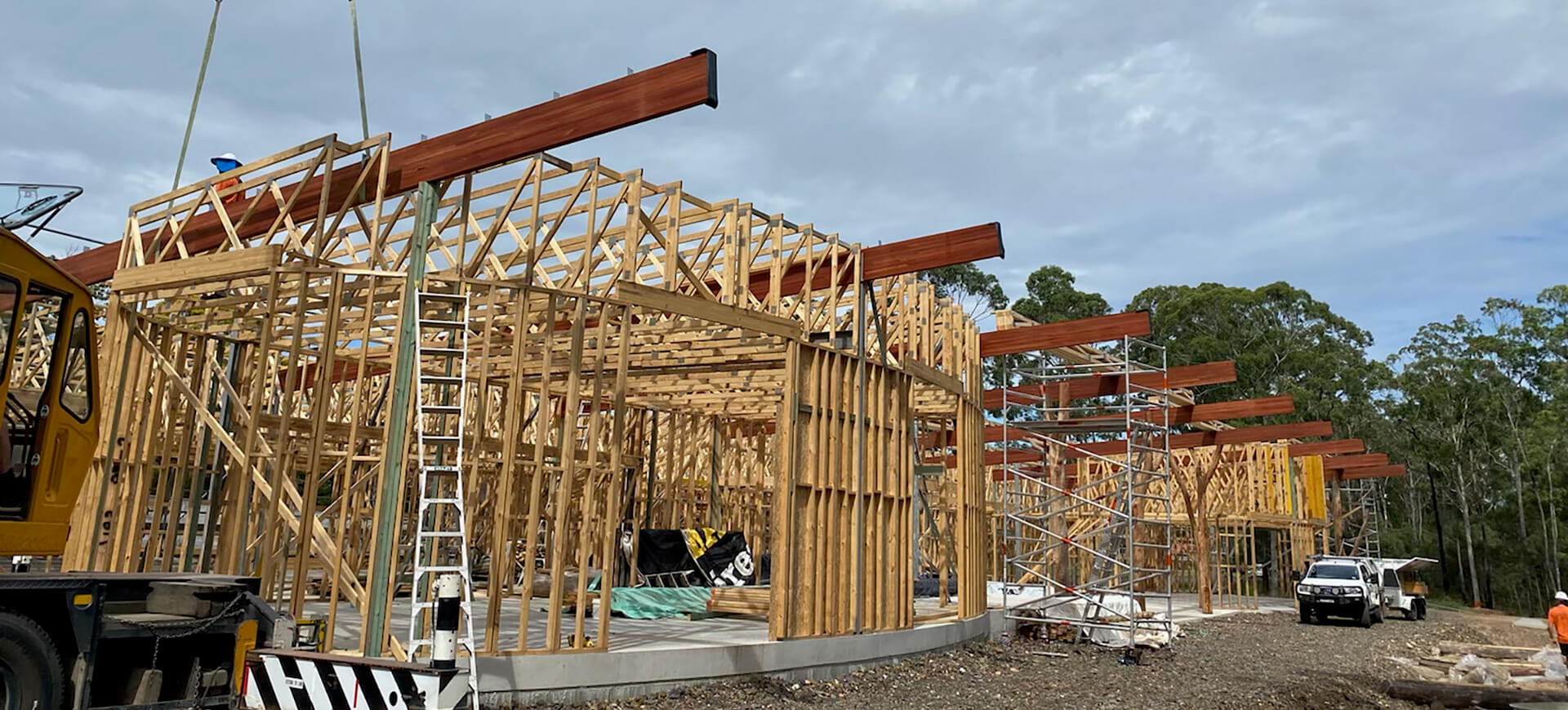FIRST STEPS COUNT COMMUNITY CENTRE
Project Details
Location
Taree
Client
W&G Duber Design and Construction
Architect
Austin McFarland Architects
Engineer
Cantilever
Material Specifications
Material
Supplied Sydney Blue Gum Timber
Specifications
9 @ 450mm x 85mm
Lengths
8 @ 13690mm
1 @ 14950mm
FIRST STEPS COUNT COMMUNITY CENTRE
Glue-laminated blue gum beams
“The experience of working with Curvwood was fantastic.” says Architect, Russel McFarland, “They were very enthusiastic about the project; the material and structural aspect as well as the social aspect of the project, and being part of the environmental designs. We were all very good at collaborating on the details and came up with very creative ways of using the supplied materials. They couldn’t have done more to make the beams work out for us.”
Exposed trees and glulam beams;
a juxtaposition of engineering and nature
It’s not often that a project comes along that embraces the very nature of its core purpose in its build. However, the First Steps Count Community Centre (FSC) does just that. It’s a project embracing biophilic design, making the most of nature and bringing it into the building. The community support and collaboration that has developed between the different project stakeholders is often rare and will be remembered long into the future.
Taking part in a project like this that embraces our values and love of wood brings with it a sense of excitement and achievement. While it has had its fair share of challenges, the teams working on the project are building on the community values in a way that reflects the building’s intention long before it’s even been completed.
The building will support FSC in delivering services, programs and a community hub for children, young people, and families.
A living building challenge
The Community Centre is being built locally by W&G Duber Design and Construction, under the project management of architect Russel McFarland from Austin McFarland Architects and engineer Damian Hadley from Cantilever. The building has been designed and developed under the Living Building Challenge™ (LBC). The LBC calls for the creation of building projects that operate as cleanly, beautifully, and efficiently as nature’s architecture.
Where possible, the building materials for the Centre are being sourced locally. It will aim to generate its own power, collect rainwater, feature community gardens, and grow bush tucker and other food sources to be shared with the community in the Centre via cooking classes and help to promote healthy eating and nutritional opportunities for young people.
The building design is set in and exploits the views and natural shapes of the forest around it, such as using naturally shaped pods for meeting areas.
Turning hiccups into opportunities
As with any project of this size and ilk, there are challenges that must be overcome. In the original design, curved glue-laminated (Glulam) Sydney Blue Gum beams were planned to support the building.
Why wood? Walter Duber, the builder, answers, “Timber is a material of choice in biophilic design as it is a renewable resource, is not as energy-intensive as steel counterparts, and is stronger than steel in a fire.”
The timber for the beams was sourced locally from Blue Gum trees. Laminated beams are engineered timber offering more strength which can be calculated to ensure they can carry the required load. It also has an added benefit – when you mill for laminated beams, you use smaller pieces that use more of the tree, making it more efficient. The timber was cut to Forest Stewardship Council (FSC) criteria for harvesting in 2019.
When the time came to engineer the laminated beams, the original supplier was no longer available. Not only that, design changes meant that the beams were no longer curved L-shaped beams, adding an extra challenge as the material for the beams had been cut to specifications for the curved beams.
They needed to source a new supplier, as close or local as possible, to engineer the beams and, if possible, use the original cut timber, which would be hard to replace.
Curvwood meets the challenge
Walter, from W&G Duber Design and Construction, reached out to Curvwood to see if they could help manufacture the nine glulam beams using Sydney Blue Gum timber that he would supply.
Curvwood agreed not only to match the original supplier price but also to identify how best to incorporate the existing cut timber to ensure the beams use only the supplied material.
“In Engineering, you’re designing something that will exist in the future, so there’s always uncertainty and so you have to plan for this. We had an in-depth conversation with Curvwood’s Operations and Technical Directors, True and Ron about whether to add metal pins into the beams to ensure they were structurally sound.”, says project engineer Damian from Cantilever.
Much to Damian’s surprise and delight, Ron spent time hand-drawing the layout of the timber lamellas to optimise the placement of the shorter cuts of timber to ensure the integrity and longevity of the laminated beams. Ron colour-coded the drawings to identify where the stresses are within the beam so you can see what the structures are doing. Ron’s decades of building and construction knowledge and experience mean that he intimately and expertly understands what the beams will be doing and what they need to support.
“Ron’s drawings, were pivotal to the manufacturing process because they identified the projected stresses, which differ at various points across the beams.” Damian calls the drawings ‘works of art’ and as such, they have been donated to the Community Centre so they can be put on display to form part of the building’s history.
Walter added, “It was part of their duty of care that was a really nice touch. You certainly don’t see hand drawings that much these days, highlighting their experience and expertise in glulam manufacturing.”
Glulam beams on trees posts
Four of the Glulam beams are resting on posts made from real trees cleared from the site during the land preparation for the build, embracing the art of biophilic design (working in harmony with nature and bringing that into the design).
Whilst adding a layer of complexity to the project, it spurred the team to find ways to make it happen.
The trees were put into place and, while standing, were cut out to hold the laminated beams. Special base plates for the posts were engineered so they could be rotated to connect to the beams, and then once the best position was identified, they were locked into place. The creative design of the baseplates allowed them to ensure perfect alignment and tolerance to get the placement right so they could support the beams.
“One thing we like about the Glulam beams used with the natural tree posts – you get the juxtaposition of the structured beams against the rustic timber tree posts, and it delivers a fantastic view showing timber can be used in both its natural and refined state. “
A fantastic experience
This prestigious project required a high degree of technical ability and a very high standard of finish. We achieved this by understanding and interpreting the client and architect’s vision and having a very close liaison with them throughout the process.
Damian reflects, “By working together as a team, we have been able to create really innovative solutions to problems and challenges that have arisen. It’s been a beautiful co-creating, collaborative process.”
Feedback from the local community has been so positive that funding has been granted for the continued development of the site. As such, Curvwood will be producing an additional three Blue Gum beams for the completion of this special community hub.

